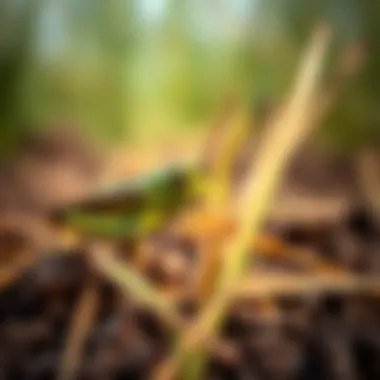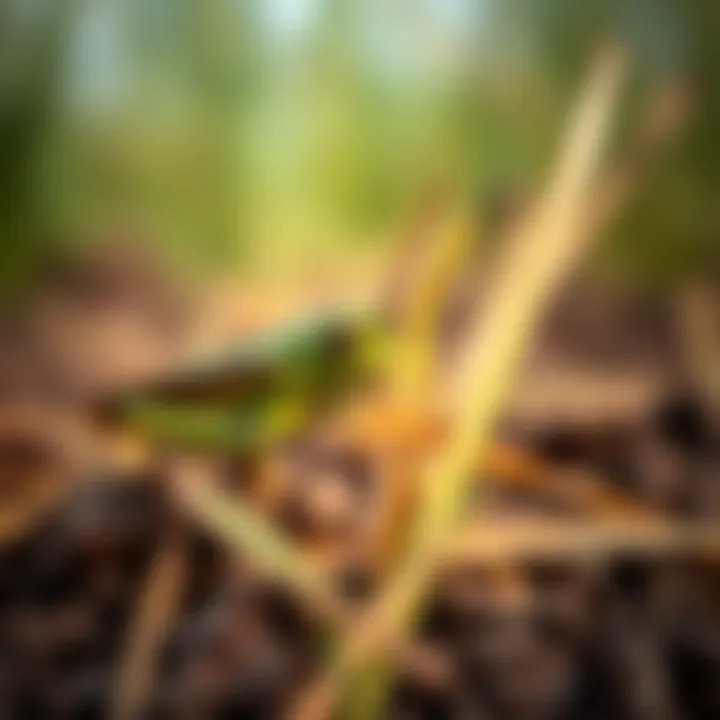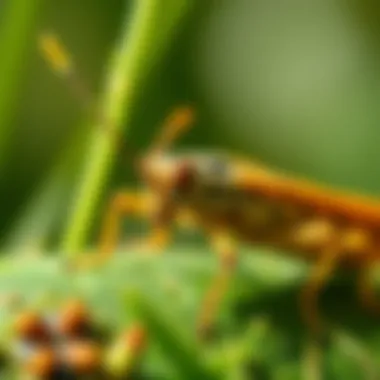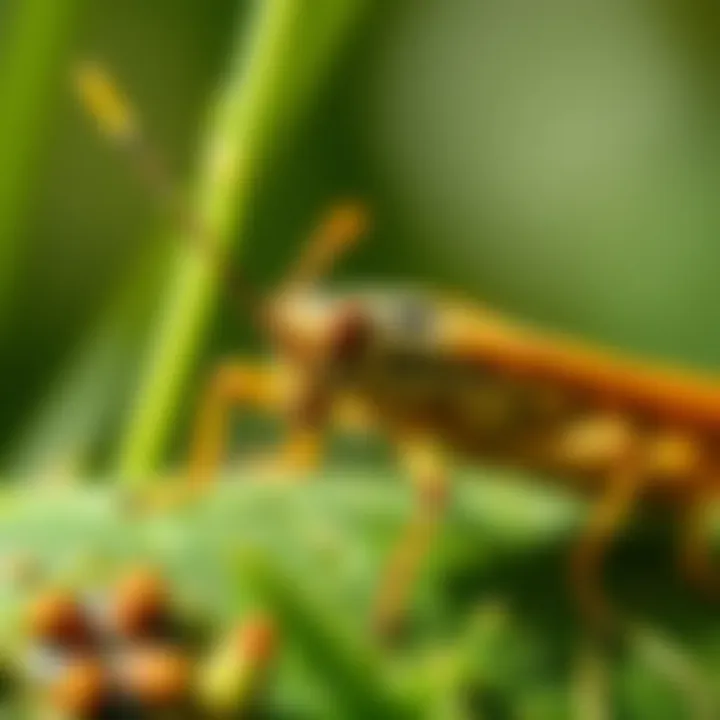Effective Strategies for Managing Grasshoppers in Gardens


Intro
Grasshoppers can be a real pain in the garden, munching on leaves and stunting plant growth. Understanding these pests is essential for anyone serious about gardening. They don’t just pop up; they have a lifecycle that opens pathways for effective control methods. Dive in as we explore what works and what doesn't against these voracious eaters.
Research and Data Analysis
Latest Trends in Agriculture and Horticulture
Agricultural practices are constantly evolving. Recently, there's been a shift toward more sustainable methods of pest control. Research shows that farmers are increasingly favoring integrated pest management (IPM) approaches. This includes understanding grasshopper behavior and their reproductive cycles, allowing for targeting their populations at critical times.
Data from various agricultural departments suggests a rising interest among growers towards organic solutions. Farmers reported improvements not only in pest management but also in overall crop health when opting for less invasive measures.
Statistical Insights into Crop Yields
The numbers speak for themselves. A study by the USDA outlined that fields suffering from high populations of grasshoppers experienced crop loss up to 30%. When compared to those employing effective control strategies, the yields were markedly higher.
"Effective grasshopper management can enhance crop yield significantly, turning potential disasters into bumper harvests."
This reinforces why understanding and addressing this pest issue is critical for anyone looking to maximize their output in the garden.
Best Practices and Techniques
Efficient Crop Management Strategies
Managing your crops isn't just about planting. It involves monitoring and adjusting practices to minimize pest damage. Here are some effective strategies:
- Timing of Planting: Planting at different times can help avoid peak grasshopper activity. If they’re not around when seeds sprout, they can't do much harm.
- Crop Diversity: Mixing up plant species can confuse grasshoppers and reduce their populations. They prefer certain grasses and plants—having a variety can lower their interest.
Sustainable Horticultural Techniques
Some gardeners are crafting solutions that not only work against grasshoppers but also encourage a healthier garden ecosystem.
- Natural Predators: Encouraging birds and beneficial insects can help control grasshopper populations. For instance, attracting birds can be done by placing bird feeders or houses throughout the garden.
- Mulching and Ground Covers: Using organic mulch can make it harder for grasshoppers to reach plants and can foster beneficial insects that prey on them.
Pest and Disease Management
Common Pests and Diseases in Crops
Grasshoppers aren't the only concern in the garden. They often share space with other pests, which magnifies the problem. Knowing what else might be lurking around, from aphids to beetles, can help in addressing the overall ecosystem.
Integrated Pest Management Strategies
Integrated Pest Management, or IPM, is all the rage for its holistic approach.
- Monitoring: Keep a close eye on your plants and use traps to gauge pest numbers. Catching them early can save a lot of grief.
- Threshold Levels: Understanding when a pest population reaches a damaging threshold can help decide when to act. Not every grasshopper needs to be eradicated, but if they get too numerous, that could be a call to action.
Culmination
Understanding Grasshoppers
Understanding grasshoppers is essential for anyone looking to maintain a healthy garden. These insects, often underestimated, can play a significant role in plant health and garden ecosystems. Recognizing their habits, life cycle stages, and species specifics enables gardeners to design effective strategies for control. Without this knowledge, one might resort to ineffective measures that exacerbate the problem rather than mitigate it.
Grasshoppers have a distinct life cycle that progresses from egg to nymph to adult. This cycle can span several months and directly affects their population dynamics. A keen awareness of their lifecycle helps in pinpointing the most effective times for intervention.
Moreover, being familiar with the behavioral characteristics of grasshoppers reveals not only how they interact with their food sources but also how they respond to environmental changes. For example, grasshoppers can be quite mobile and can quickly relocate when threatened, which might require different strategies compared to stationary pests.
Identifying the various grasshopper species present in your garden can also make a world of difference. Certain species are more destructive than others. This knowledge allows for tailored responses that are both environmentally friendly and effective.
In sum, comprehending grasshoppers isn't just about knowing your enemy; it's about understanding the balance within your garden ecosystem. With these insights, you can cultivate not just a garden, but a thriving environment that withstands the pressures of grasshopper invasions.
Life Cycle of Grasshoppers
The life cycle of grasshoppers is made up of three main stages: egg, nymph, and adult. The journey begins when females lay their eggs in the ground, often in clusters. This stage can occur during late summer to fall. The eggs hibernate until spring, when warmth encourages them to hatch. The newly hatched nymphs resemble miniature adults, but without wings.
Nymphs go through a series of molts, shedding their exoskeletons and growing in size. As they progress through four to six nymphal stages, they gradually develop wings and mature into adults, typically within two to three months. Understanding this cycle gives you a clearer timeline for control measures. For instance, targeting the nymphs as they hatch—before they reach adulthood—might be far more effective than waiting for a fully-grown adult to appear.
Behavioral Characteristics
Grasshoppers are known for their voracious appetites and rapid movements. They thrive in warm weather, often becoming pests during the summer when they are most active. Their feeding behavior is straightforward: they consume foliage, with a particular liking for tender young plants. This can lead to significant damage if their populations aren't controlled.


Interestingly, grasshoppers are social insects. They can often be found in groups, which amplifies their impact on vegetation. When disturbed, they will jump away quickly, their powerful hind legs allowing them to take flight at a moment's notice. This means that conventional trapping methods might not be very effective since they can easily evade danger.
Understanding these behaviors helps gardeners anticipate when grasshoppers are likely to be on the move and plan accordingly. For example, knowing they are most active midday can inform the timing of protective actions, whether those are physical barriers or the application of natural deterrents.
Identifying Grasshopper Species
Identifying grasshopper species is crucial because different types can cause varying levels of damage. Over a thousand species exist in the United States alone, and not all of them pose a threat to your garden. For instance, the common short-horned grasshopper is often seen munching on garden plants, whereas the migratory species might not linger long enough to cause substantial damage.
Using field guides or online resources like Wikipedia can assist in identifying these insects based on their physical characteristics, such as color, size, and markings. Contributions from community sites like Reddit or specialized Facebook groups can also provide valuable insights and shared experiences from fellow gardeners dealing with similar pest issues.
In summary, a thorough understanding of grasshoppers, from their lifecycle to their behaviors and specific species identification, sets the groundwork for effective garden management strategies. With this backbone of knowledge, managing your garden and sustaining its health becomes not just a task, but a more strategic endeavor.
Assessing Grasshopper Damage
Assessing the damage caused by grasshoppers is a key step in managing their presence in your garden. Understanding the signs and evaluating the extent of this damage allows gardeners to take timely and effective action, tailoring solutions to the specific situation. Without a clear grasp of how grasshoppers are impacting plant health, one may waste time and effort on ineffective measures or miss the opportunity to implement necessary interventions.
Symptoms of Infestation
When it comes to identifying a grasshopper problem, awareness of the symptoms is vital. These pests can wreak havoc if left unchecked. Some common symptoms that indicate an infestation include:
- Chewed Leaves: The most visible sign is often the ragged edges or holes in leaves, especially on young plants. Grasshoppers often prefer tender foliage, leaving plants looking like they’ve been through the wringer.
- Reduced Growth: Stunted plant development can occur due to constant feeding. Keep an eye on plants that fail to thrive; grasshoppers might be the culprits.
- Significant Population Presence: Sightings of numerous grasshoppers, especially during warm months, should raise a red flag. Finding them in clusters or hopping around can indicate an encroaching problem.
- Droppings: Another telltale sign is the presence of grasshopper droppings, which resemble small dark pellets. If you spot these around your plants, it’s likely your garden has been invaded.
- Loss of Flowers or Fruit: For gardeners who grow fruiting plants or flowers, an explosion in grasshopper population may lead to reduced yields. Monitor your harvest closely for any missing parts.
Evaluating the Extent of Damage
Once you've identified symptoms of a grasshopper infestation, evaluating the severity of the damage becomes the next crucial step. This evaluation involves observing a few key elements:
- Inspecting Plant Species: Different plant species can endure varying levels of damage. Document which plants are affected most severely and categorize them by their vulnerability.
- Assessing Damage Levels: Feel free to take a closer look at individual plants. Are only a few leaves affected, or are entire branches stripped bare? Allocate a percentage value to the damage—this helps in prioritizing your response efforts.
- Monitoring Reproduction Cycles: Understanding the life cycle of grasshoppers can inform you about potential future infestations. If you notice high levels of damage in late summer, it’s important to consider how many eggs were laid that season.
- Evaluating Environmental Conditions: Factors such as soil health and moisture can influence how plants react to grasshopper feeding. Assess your garden's resilience by considering if the plants can recover post-infestation.
- Documenting Findings: Keep a log of your observations, both for the current season and to reference in future seasons. This can provide insights into patterns and recurring issues, which is invaluable when developing a long-term management strategy.
"Only by keeping a keen eye on your plants can you effectively manage grasshopper populations and protect your garden’s health."
In summary, assessing grasshopper damage is not just about spotting the insects, but also involves a detailed understanding of the impacts they have on your garden. With accurate information and careful analysis, gardeners can take the necessary steps to mitigate damage and foster a more thriving environment.
Preventive Strategies
When it comes to keeping your garden thriving and free from grasshopper invasions, prevention is the name of the game. This section delves into Preventive Strategies that play a critical role in deterring grasshoppers before they become a problem. Adopt these strategies not only to protect your plants but also to create a gardening ecosystem that promotes healthy growth.
Creating a Healthy Garden Environment
A garden thriving with health creates an unfavorable environment for grasshoppers. Healthy plants are more resilient to pest damage, making it essential for gardeners to focus on soil health, proper watering, and nurturing plant diversity. Here are a few steps to take:
- Soil Quality: Regularly amend your soil with organic materials like compost. This promotes beneficial microorganisms that contribute to robust plant health.
- Diverse Planting: Grasshoppers prefer certain plants, so introducing a variety of flowers and herbs can confuse these pests, dispersing their target.
- Adequate Watering: Make sure not to overwater, as too much moisture can lead to root rot and weak plants, which are more susceptible to infestations.
In essence, by crafting a well-balanced garden environment, you are less likely to attract grasshoppers.
Utilizing Companion Planting
Companion planting can be a game-changer in your fight against grasshopper infestation. By strategically planting specific crops alongside each other, you can create a natural deterrent. Here are some effective combinations:
- Sage and Cabbage: The strong smell of sage can deter grasshoppers that are drawn to cabbage.
- Marigolds: These bright blooms not only add color to your garden but also emit a scent that disorients grasshoppers.
- Basil and Tomatoes: Basil's aroma repels various garden pests, including grasshoppers, while promoting the growth of tomatoes.
Remember to research which plants thrive together; this will not only enhance pest control but also optimize your garden's productivity.
Managing Landscape Features
Your garden's layout and surroundings can greatly influence grasshopper activity. Be mindful of these landscape features that can either attract or repel these pests:
- Clear Debris: Grasshoppers often hide in tall grass and debris, especially near the edges of your garden. Regular cleanup will minimize these hiding spots.
- Use Barriers: Installing physical barriers, such as netting around vulnerable crops, will prevent grasshoppers from reaching your plants.
- Sunlight and Wind: A garden layout that maximizes sunlight and wind exposure can deter grasshoppers since they prefer sheltered environments.
By taking control of your landscape features, you reduce the allure of your garden to invasive grasshoppers.
In summary: A proactive approach through preventive strategies not only keeps grasshoppers at bay but also fosters an environment where your plants can flourish. Directing efforts towards soil health, companion planting, and landscape management is crucial for sustaining a thriving garden while minimizing grasshopper populations.
Natural Deterrents
When it comes to managing grasshoppers in your garden, natural deterrents play a pivotal role. They offer an eco-friendly solution, reducing reliance on chemicals while still protecting your plants. These methods align well with a sustainable gardening philosophy, encouraging biodiversity in your backyard and minimizing harm to the ecosystem. Plus, they often leverage easily accessible ingredients, making them a practical choice for many gardeners.
Using natural deterrents can also foster a healthier soil and plant dynamic. By encouraging beneficial organisms and utilizing organic materials, you cultivate a robust growing environment that can withstand pest invasions. Moreover, adopting these strategies can lead to a safer landscape for your pets and children. Now, let's delve into some effective homemade solutions.


Homemade Sprays
Garlic Spray
Garlic spray is a favored method among gardeners due to its natural repellent properties. This homemade concoction works wonders against grasshoppers by emitting a strong scent that they find unpalatable. The key characteristic that sets garlic spray apart is its easy preparation; all you need is garlic, water, and a bit of oil. This simplicity makes it a popular choice for anyone looking to manage pests without complicating their routine.
One notable advantage of garlic spray is its eco-friendliness. It is non-toxic and does not linger in the environment, ensuring a safe space for nearby wildlife. However, a unique feature to be aware of is that garlic spray needs frequent reapplication, especially after rain. Additionally, while it wards off grasshoppers, it might not deter all pests, meaning gardeners often need to integrate it with other methods for full-spectrum protection.
Pepper Spray
Pepper spray, on the other hand, utilizes the pungent heat of peppers to repel grasshoppers. This homemade formula is not only easy to create but also acts as a multi-purpose pest deterrent. Gardeners appreciate pepper spray for its potent characteristics, as the spiciness can confound and drive away many insects. Mixing crushed red pepper or hot sauce with water leads to a simple, yet effective, spray solution.
Its effectiveness stems from the natural compounds in the peppers that disrupt pests' feeding habits while also providing an additional barrier when sprayed onto the plant leaves. However, the unique feature of pepper spray that can be both an advantage and disadvantage is its sensitivity to weather. Heavy rain or watering can wash it away, requiring gardeners to keep an eye on their applications and possibly reapply after wetter spells to maintain efficacy.
Essential Oils and Their Efficacy
Essential oils have emerged as a powerful tool in the fight against grasshoppers. Certain oils, like peppermint and rosemary, contain compounds that can disrupt the insects' sensory perception. This disruption makes it difficult for grasshoppers to locate host plants, ultimately protecting your garden from their feeding frenzy.
The beauty of using essential oils lies in their concentration. Just a few drops mixed with water can create a potent deterrent. While they can be effective, it’s crucial to dilute them properly, as high concentrations might harm beneficial insects alongside the grasshoppers you aim to rid from your garden. This calls for careful application and the understanding of which beneficial insect populations you might risk impacting in the process.
Encouraging Natural Predators
Natural predators serve as a significant line of defense against grasshoppers. By attracting the right wildlife to your garden, you create a balanced ecosystem that helps keep pest populations in check.
Birds
Birds, in particular, play a formidable role in controlling grasshopper numbers. They are natural hunters of these pests and can consume them in large quantities. Attracting birds to your garden can be accomplished by providing birdhouses, feeders, and water sources. The key characteristic of birds is their eagerness to feed on grasshoppers, making them a beneficial choice for maintaining garden health.
One unique feature of encouraging birds is their additional role as pollinators, enhancing the overall productivity of your plants. However, a disadvantage may arise if you attract too many birds that become overly dependent on your garden as a food source, potentially disrupting local fauna dynamics.
Beneficial Insects
Beneficial insects, such as ladybugs and lacewings, also contribute to grasshopper control. These organisms can prey on grasshopper eggs and young nymphs, effectively reducing their populations before they become a problem. The main characteristic of these beneficial insects is their specific diet, which can target multiple pest species. By cultivating a habitat that attracts these friendly bugs, you're taking proactive steps to bolster your pest management strategies.
However, a unique feature of relying on beneficial insects is the necessity of creating an inviting environment for them, which often involves planting specific flowers that provide nourishment. The drawback here could be the time and effort needed to establish this balanced ecosystem, but the long-term benefits typically outweigh the initial investment of labor and resources.
By combining various natural deterrents and encouraging wildlife, you can significantly diminish grasshopper populations while promoting a thriving garden ecosystem.
Chemical Control Methods
When it comes to managing grasshopper populations, chemical control methods often play a pivotal role, especially when populations are high and natural methods alone aren't sufficient. In this section, we drill into the importance of these methods in protecting your garden.
Several aspects highlight the relevance of chemical control. First, when faced with a burgeoning grasshopper infestation, resorting to insecticides can quickly reduce their numbers. Additionally, effective application can keep your garden healthy by minimizing the devastation these pests can wreak on your plants, ultimately safeguarding your hard work from going to waste. However, it’s crucial to handle these substances with care, considering their potential impacts on the environment and non-target organisms.
Insecticides: Types and Applications
Understanding the different types of insecticides is key to selecting the right one for your situation. Broadly speaking, these can be classified into several categories:
- Contact Insecticides: These products are effective as they kill pests on contact. They are usually applied directly onto the grasshoppers or the foliage where they feed. Examples include carbaryl and pyrethroids.
- Systemic Insecticides: These are absorbed by the plant and can be ingested by the grasshoppers when they chew on the leaves. This method ensures that even those hard-to-reach insects are dealt with, making it useful for preventative applications.
- Bait Insecticides: These types are designed to attract grasshoppers, lacing a food source with a toxin. The grasshoppers consume the bait and perish, which can be an effective strategy in reducing large populations.
Proper application methods are essential. Always follow the instructions on the product label, which typically detail the correct dosage, timing, and methods for application. This ensures that you not only tackle the pest effectively but also minimize risks to beneficial insects and the surrounding ecosystem.
When using chemical treatments, a balanced approach is crucial: targets pests efficiently while considering environmental impacts.
Safety Considerations for Chemical Use
Before diving into chemicals, you must keep safety front of mind. Protective gear must be the order of the day. Gloves, masks, and eyewear safeguard you from potential harm.
Here are some useful safety considerations:
- Read Labels Carefully: Each insecticide comes with specific instructions. Ensuring that you understand the requirements before application cannot be overstated. This also includes understanding any re-entry intervals which dictate when you can safely return to treated areas.
- Avoid Contamination: Chemicals can easily drift or leach into water systems, so choose appropriate weather conditions for application. Avoid windy days and ensure you’re not near bodies of water.
- Store Safely: Keep leftover chemicals in their original containers, tightly sealed, and out of reach of children and pets to prevent accidental ingestion.
Through informed choices and careful practices, chemical control methods add a valuable tool to your gardening toolkit. Utilizing these approaches in combination with other methods can create a robust system for keeping grasshoppers at bay.
Cultural Control Techniques
Cultural control techniques are pivotal in managing grasshopper populations in gardens. Unlike chemical interventions, these methods focus on modifying the gardening environment, thereby influencing grasshopper behavior and survival. Utilizing cultural practices not only aids in reducing the immediate grasshopper threat but also promotes a holistic approach to gardening that benefits overall plant health. The essence of these strategies lies in their sustainability and minimal environmental impact.


Crop Rotation
Crop rotation is a cornerstone of cultural practices, and its role in pest management cannot be overstated. By alternating the types of crops planted in a specific area each season, gardeners can disrupt the life cycles of grasshoppers, which often have preferences for certain plants. For example, if a gardener consistently plants alfalfa, grasshoppers may establish a strong presence there, leading to severe infestations. By rotating crops, say from alfalfa to tomatoes, grasshoppers find themselves without their favored food source, eventually reducing their numbers.
Moreover, different crops can attract diverse natural predators that keep pest populations in check. For instance, planting legumes followed by cereals can encourage beneficial insects like ladybugs and predatory wasps, which provide an added layer of protection.
- Benefits of Crop Rotation:
- Considerations:
- Disrupts pest cycles.
- Enhances soil health.
- Reduces the build-up of pathogens.
- Understanding which crops suit your region is key.
- It might take time to observe significant changes in pest populations.
"Crop rotation is like refreshing the garden's playlist, giving pests a new tune to consider."
Proper Watering and Fertilization
Water and nutrients play pivotal roles in plant vigor, influencing not just growth but also pest resilience. Grasshoppers thrive in poorly maintained environments where plants are stressed due to inadequate watering or nutrient deficiencies. A well-watered, properly fertilized garden can strengthen plants, making them less appealing to grasshoppers.
When it comes to watering, adopting a consistent schedule is essential. Deep watering encourages roots to grow below the surface where they are less susceptible to grasshopper feeding. It also helps prevent the wilting of plants during dry spells, attracting pests looking for easy meals.
Likewise, fertilization must be approached with care. Over-fertilization can lead to lush, soft growth that is more appealing to grasshoppers. Instead, balance is key. Gradual feeding with organic fertilizers can promote healthy growth without creating a feast for pests.
- Key Practices of Proper Watering and Fertilization:
- Water deeply but infrequently.
- Use organic fertilizers to enrich soil slowly.
- Monitor plant conditions regularly.
These maneuvers create a robust environment where grasshoppers find it challenging to establish themselves while also enhancing the overall health and productivity of the garden.
In summary, cultural control methods, particularly crop rotation and wise watering and fertilization practices, not only deter grasshoppers but also cultivate a thriving garden ecosystem.
Monitoring and Evaluation
Monitoring and evaluation are crucial components in the realm of pest management, particularly when dealing with persistent nuisances like grasshoppers. A strategic approach to monitoring allows garden enthusiasts to keep a close eye on grasshopper populations and their effects on plants. The practice not only identifies potential problems early on but also aids in refining control measures. By evaluating the effectiveness of implemented strategies, one can make informed adjustments to practices, ensuring a sustainable and thriving garden environment.
Establishing a Monitoring Plan
Establishing a monitoring plan is akin to setting a roadmap for success in managing grasshopper populations. The first step is determining which areas of the garden are prone to grasshopper activity. One effective method involves surveying the garden regularly during the peak grasshopper season, typically late spring through summer.
- Observation Techniques: Use visual inspections to look for the tell-tale signs of grasshoppers. Look closely at the foliage for damage as well as adult grasshoppers or their young ones hopping around.
- Data Collection: Jot down observations in a gardening journal. This should include the number of grasshoppers seen, types of plants affected, and any notable changes over time.
- Survey Frequencies: Set specific intervals for these surveys, whether that be once a week or biweekly. More frequent checks during peak times can unearth issues before they escalate.
By adhering to this structured plan, you can create a clear picture of grasshopper activities in your garden, which in turn informs your subsequent actions for effective control.
Adjusting Strategies Based on Observations
Once you have established a solid monitoring plan and gathered data over a period, it becomes necessary to adjust your strategies based on the observations. This adaptive management approach allows gardeners to be proactive rather than reactive.
- Evaluate the Data: Review the information collected. Are there particular plants that seem to attract more grasshoppers? Have there been spikes in their populations at certain times?
- Modify Control Measures: If certain natural deterrents, like homemade sprays, have proven ineffective, it may be time to explore alternative methods. For instance, if garlic spray hasn't deterred grasshoppers sufficiently, consider boosting its concentration or testing other deterrents like essential oils.
- Introduce New Tactics: Based on insights gained, you might decide to implement new techniques like planting specific companion plants that are known to repel grasshoppers.
"In pest management, knowledge is power. The more you observe, the better you adapt."
Adapting strategies is a continuous process, and it may take time to find the perfect balance. Your willingness to adjust based on real-time data collected through diligent monitoring can truly make a difference in creating a resilient garden that thrives despite the odds.
Long-Term Management Practices
Long-term management practices are crucial when it comes to dealing with grasshopper populations in your garden. Instead of just addressing immediate infestations, these strategies focus on fostering a sustainable ecosystem, reducing the chances of future outbreaks. By implementing these practices, gardeners can not only combat current grasshopper issues but also enhance the overall health of their gardens for years to come.
Building Resilience in Your Garden
Creating a resilient garden means working with nature rather than against it. This involves several layered strategies:
- Diverse Plant Selection: Growing a variety of plants can confuse grasshoppers, making it harder for them to find food. Think about incorporating perennials, native plants, and even some ornamental varieties. Plants like chamomile and yarrow can enhance biodiversity, which naturally counters pest populations.
- Healthy Soil Management: Healthy soil nurtures stronger plants. Use compost and organic matter to enrich your soil. This boosts plant vigor, making them less susceptible to fearsome nibblers like grasshoppers.
- Smart Watering Techniques: Proper watering not only promotes healthy plant growth but also can deter grasshoppers. Overly wet conditions can lead to root rot, while overly dry plants are more appealing to them. Aim for a consistent watering schedule according to the needs of your plants.
- Mulching: Applying mulch around your plants can create a barrier that deters grasshoppers. It also maintains moisture levels in the soil, encouraging robust plant growth.
Building resilience isn't a one-and-done deal; it’s a continuous effort. Regularly assessing plant health and soil conditions while adjusting your practices can turn your garden into a fortress against grasshoppers.
Educating Yourself on Pest Management
Knowledge is power when it comes to effective pest management, and that certainly rings true for grasshoppers. Understand your enemy by diving deep into their habits and lifecycle. Here are some key elements:
- Research Grasshopper Behavior: Familiarize yourself with the springtime behaviors of grasshoppers. Knowing when they lay eggs and how often they feed will help you create a proactive management plan.
- Stay Updated on New Strategies: The world of pest management is constantly evolving. Read up on newer, eco-friendly methods as they emerge. Websites like University of California Agriculture and Natural Resources offer excellent insights into integrated pest management plans.
- Join Local Gardening Groups: Being part of a gardening community allows for the sharing of experiences and tips. You can find useful advice to combat grasshopper problems and perhaps even get recommendations for specific varieties that resist pests better.
- Continual Learning: Attend workshops or webinars focused on pest management and organic gardening. These can provide practical knowledge that can make a difference in your own gardening practices.
"Gardening requires lots of water, sunshine, and a touch of humility.” - Unknown
For further information, consider reading resources from National Gardening Association and extension.org. They frequently publish materials regarding best practices in pest management.















